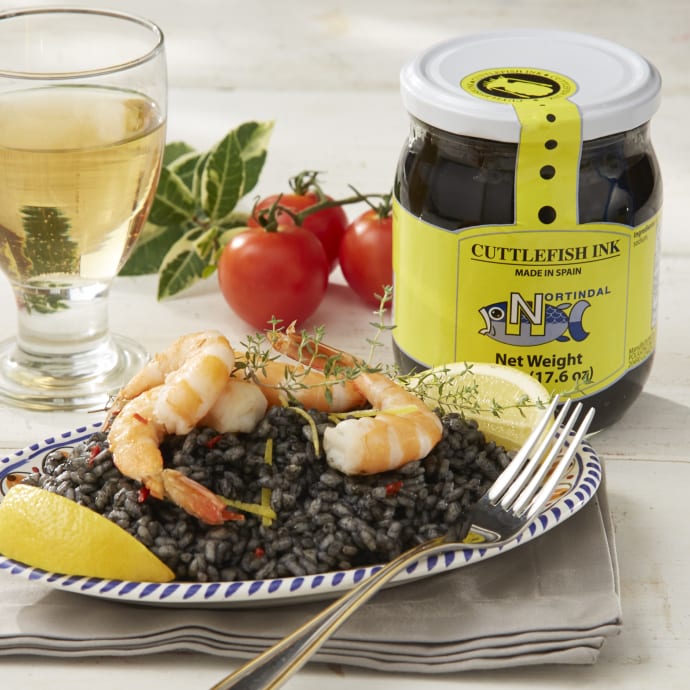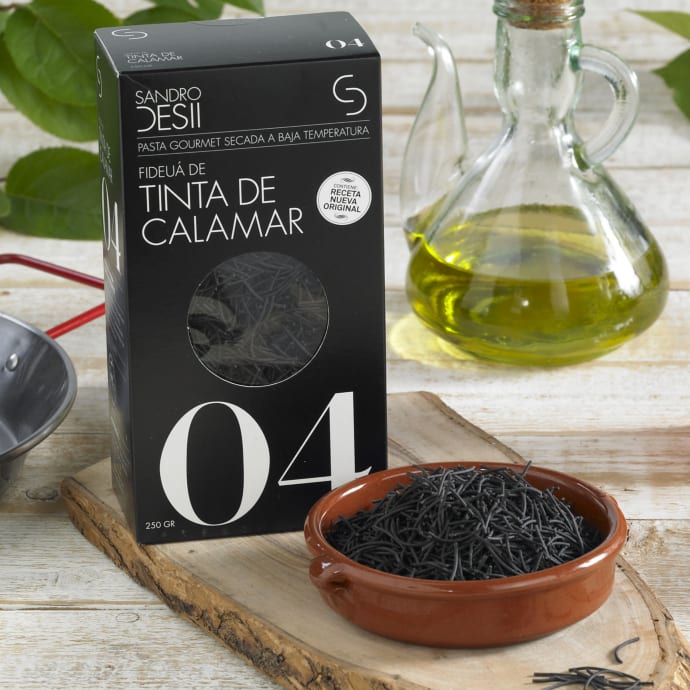Three Kings Sale - Up to 40% Off! Shop Sale

Sleuthing Squid Ink
Gourmet Magazine
-
February 11, 2009
Charles Kelsey
Most of us know the jet-black substance from its presence in tasteless dried pastas. So what’s its appeal? squid ink
I’ve always been intrigued by squid ink and mainly because it turns food strikingly jet-black. Now that’s just cool. Unfortunately, it’s one of those ingredients I’ve never truly experienced or cooked with, and sadly, it’s in my mental ingredient file as:
squid ink: a coloring agent that turns your food black; a staple of the Goth diet
Pretty lame, right? But I’ve only ever eaten dried squid-ink pasta (those sad, tasteless noodles found in every crappy specialty food store) and a Goth kid who rode my bus in high school once told me arroz negro was his favorite food because everything black feeds his soul (he was from Valencia; loved Bauhaus; true story). Worse yet, whenever I’ve taken a serious interest and asked ink-loving friends and culinary pros for a specific flavor description, they’ve all told me it’s briny with a rich seafood essence. Great. Thanks. That also describes the flavor of oysters, monkfish, sea hares, manta rays, sponges, and basically anything from the ocean. Clearly, it was time to acquaint myself with squid ink and figure out its culinary appeal.
Andrew Carmellini, author of Urban Italian and former A Voce chef, shed some light on the pitch-dark world of squid ink for me. He said, in addition to the briny/seafood thing, there’s a deep, subtle murkiness that makes the ingredient so complex: “It just has this earthiness, not like mushrooms, but more like old, wet leaves.” He compared the mouthfeel to eating black truffles, explaining that the ink has a full, round sensation on the palate. When it comes to cooking, Carmellini sticks to the classic squid ink dishes: “They’re so great. I find I don’t stray too far from them—I’m not really into squid ink ice cream or anything like that. Also, I think one of the best applications is squid ink in rice—even more so than in pasta. With the rice, the ink gets absorbed better.”
With all that goodness in mind, I bought a giant jar of squid ink (harvesting your own is a monumental pain in the rear) and took Carmellini’s advice to cook up some classics. Before I got started, however, I noticed my squid ink wasn’t squid ink. It was from cuttlefish—the squid’s larger, thick-fleshed cousin. Concerned that I might be cheating if I used cuttlefish ink instead of true squid ink, I found this info from Marcella Hazan’s Essentials of Classic Italian Cooking that put me at ease: “To the Italian palate, the harsh, pungent ink is the least desirable part of the squid. As Venetian cooks have shown, it’s only the mellow, velvety, warm-tasting ink of cuttlefish—seppie—that is suitable for pasta sauce, risotto, and other black dishes.” I did a bit more shopping around, and it appeared that most of the “squid ink” on the market is actually cuttlefish ink. Ready to get my ink on, I made the following: fresh cuttlefish-ink tagliatelle with capers, tuna, and olive oil; fusilli and squid in cuttlefish ink; arroz negro (black rice); txipirones en su tinta (baby squid in ink sauce); Philippine squid adobo; Ikasumi jiru (an Okinawan ink soup with pork and squid).
It was a squid-ink banquet. By the time I finished, my teeth were black and I had definitely gained a better appreciation for the guest of honor. When I accidentally added too much ink to the fusilli sauce, I discovered how incredibly rich the ink can make a dish (rich with body, like a reduced meat sauce; think demi-glace). And chef Carmellini was right about the rice: The simple arroz negro was incredible, and if I were a Goth I would certainly choose it to fuel my dark, brooding, bad-poetry-effusing soul. But my absolute favorite was the Okinawan soup. It was a stunning pool of blackness with an attractive sheen, and the combo of pork and squid ink was stellar (come to think of it, Carmellini did mention that chorizo is also a killer accompaniment to ink). Frankly, though, it’s hard to describe what specific flavor the squid ink added to any of the dishes. Yes, it was briny and seafood-y with a murkiness, but it was doing more than just adding a discrete flavor. It added body and fullness, but more importantly it seasoned and intensified the dishes’ other ingredients, bringing them together in a high-pitched harmony. The effect was easy to dismiss as alchemy, but there had to be a good explanation.
I looked into squid ink’s chemical composition, but found nothing on my own. Stephanie L. Bush, a U.C. Berkeley graduate student and a researcher at the Monterey Bay Aquarium Research Institute, turned out to be a huge help. Her dissertation research focuses on the defensive behaviors of deep-sea squid, and part of that entails studying the makeup of squid ink. Turns out that the specific chemical composition of squid ink really is a mystery. Bush explained that melanin, a pigment, gives the ink its color, and there are different amino acids present. For more specifics she recommended I check out a paper called Chemical Composition of Inks of Diverse Marine Molluscs Suggests Convergent Chemical Defenses[1] (really). In it, I found my answer for squid ink’s kickass seasoning effect: High concentrations of glutamic acid, also (improperly) known as glutamates. Like MSG, fish sauce, soy sauce, or Parmigiano-Reggiano, squid ink adds to food that alluring fifth taste: umami. Deliciousness. It all came into focus. The truffle-y sensation, the inability for anyone to describe it, the way it brings flavors in a dish together. Damn, squid ink is cool.
Squid Ink Sources
Your local fishmonger should be able to hook you up with some squid ink; however, you may need to put in a special request. Plan B: Order it online from tienda.com or gourmetfoodstore.com.
Most of us know the jet-black substance from its presence in tasteless dried pastas. So what’s its appeal? squid ink
I’ve always been intrigued by squid ink and mainly because it turns food strikingly jet-black. Now that’s just cool. Unfortunately, it’s one of those ingredients I’ve never truly experienced or cooked with, and sadly, it’s in my mental ingredient file as:
squid ink: a coloring agent that turns your food black; a staple of the Goth diet
Pretty lame, right? But I’ve only ever eaten dried squid-ink pasta (those sad, tasteless noodles found in every crappy specialty food store) and a Goth kid who rode my bus in high school once told me arroz negro was his favorite food because everything black feeds his soul (he was from Valencia; loved Bauhaus; true story). Worse yet, whenever I’ve taken a serious interest and asked ink-loving friends and culinary pros for a specific flavor description, they’ve all told me it’s briny with a rich seafood essence. Great. Thanks. That also describes the flavor of oysters, monkfish, sea hares, manta rays, sponges, and basically anything from the ocean. Clearly, it was time to acquaint myself with squid ink and figure out its culinary appeal.
Andrew Carmellini, author of Urban Italian and former A Voce chef, shed some light on the pitch-dark world of squid ink for me. He said, in addition to the briny/seafood thing, there’s a deep, subtle murkiness that makes the ingredient so complex: “It just has this earthiness, not like mushrooms, but more like old, wet leaves.” He compared the mouthfeel to eating black truffles, explaining that the ink has a full, round sensation on the palate. When it comes to cooking, Carmellini sticks to the classic squid ink dishes: “They’re so great. I find I don’t stray too far from them—I’m not really into squid ink ice cream or anything like that. Also, I think one of the best applications is squid ink in rice—even more so than in pasta. With the rice, the ink gets absorbed better.”
With all that goodness in mind, I bought a giant jar of squid ink (harvesting your own is a monumental pain in the rear) and took Carmellini’s advice to cook up some classics. Before I got started, however, I noticed my squid ink wasn’t squid ink. It was from cuttlefish—the squid’s larger, thick-fleshed cousin. Concerned that I might be cheating if I used cuttlefish ink instead of true squid ink, I found this info from Marcella Hazan’s Essentials of Classic Italian Cooking that put me at ease: “To the Italian palate, the harsh, pungent ink is the least desirable part of the squid. As Venetian cooks have shown, it’s only the mellow, velvety, warm-tasting ink of cuttlefish—seppie—that is suitable for pasta sauce, risotto, and other black dishes.” I did a bit more shopping around, and it appeared that most of the “squid ink” on the market is actually cuttlefish ink. Ready to get my ink on, I made the following: fresh cuttlefish-ink tagliatelle with capers, tuna, and olive oil; fusilli and squid in cuttlefish ink; arroz negro (black rice); txipirones en su tinta (baby squid in ink sauce); Philippine squid adobo; Ikasumi jiru (an Okinawan ink soup with pork and squid).
It was a squid-ink banquet. By the time I finished, my teeth were black and I had definitely gained a better appreciation for the guest of honor. When I accidentally added too much ink to the fusilli sauce, I discovered how incredibly rich the ink can make a dish (rich with body, like a reduced meat sauce; think demi-glace). And chef Carmellini was right about the rice: The simple arroz negro was incredible, and if I were a Goth I would certainly choose it to fuel my dark, brooding, bad-poetry-effusing soul. But my absolute favorite was the Okinawan soup. It was a stunning pool of blackness with an attractive sheen, and the combo of pork and squid ink was stellar (come to think of it, Carmellini did mention that chorizo is also a killer accompaniment to ink). Frankly, though, it’s hard to describe what specific flavor the squid ink added to any of the dishes. Yes, it was briny and seafood-y with a murkiness, but it was doing more than just adding a discrete flavor. It added body and fullness, but more importantly it seasoned and intensified the dishes’ other ingredients, bringing them together in a high-pitched harmony. The effect was easy to dismiss as alchemy, but there had to be a good explanation.
I looked into squid ink’s chemical composition, but found nothing on my own. Stephanie L. Bush, a U.C. Berkeley graduate student and a researcher at the Monterey Bay Aquarium Research Institute, turned out to be a huge help. Her dissertation research focuses on the defensive behaviors of deep-sea squid, and part of that entails studying the makeup of squid ink. Turns out that the specific chemical composition of squid ink really is a mystery. Bush explained that melanin, a pigment, gives the ink its color, and there are different amino acids present. For more specifics she recommended I check out a paper called Chemical Composition of Inks of Diverse Marine Molluscs Suggests Convergent Chemical Defenses[1] (really). In it, I found my answer for squid ink’s kickass seasoning effect: High concentrations of glutamic acid, also (improperly) known as glutamates. Like MSG, fish sauce, soy sauce, or Parmigiano-Reggiano, squid ink adds to food that alluring fifth taste: umami. Deliciousness. It all came into focus. The truffle-y sensation, the inability for anyone to describe it, the way it brings flavors in a dish together. Damn, squid ink is cool.
Squid Ink Sources
Your local fishmonger should be able to hook you up with some squid ink; however, you may need to put in a special request. Plan B: Order it online from tienda.com or gourmetfoodstore.com.
Other Press
The Winter Travel Shortlist: Problem-Solving Essentials I’m Packing This Season
Forbes
-
November 20, 2025
54 Gifts for People Who Have Everything
Wirecutter
-
November 6, 2025
What Andrew Zimmern Can’t Live Without
The Strategist
-
June 30, 2025
8 Tasty Ways To Travel The World With Food
Forbes
-
June 17, 2025
Featured Products

Squid Ink by Nortindal
SE-136
$9.00$9.00

Tinta de Calamar - Squid Ink (Large Jar)
SE-112
(11)
$39.00$39.00

Chipirones en su Tinta - Squid in Ink Sauce by Ramón Peña
SE-172
(2)
$22.00$22.00

Chipirones en su Tinta by Conservas de Cambados - Baby Squid in Ink
SE-87
(5)
$29.00$29.00

Fideuá de Tinta de Calamar - Black Fideo Pasta
SU-27
$14.00$14.00





